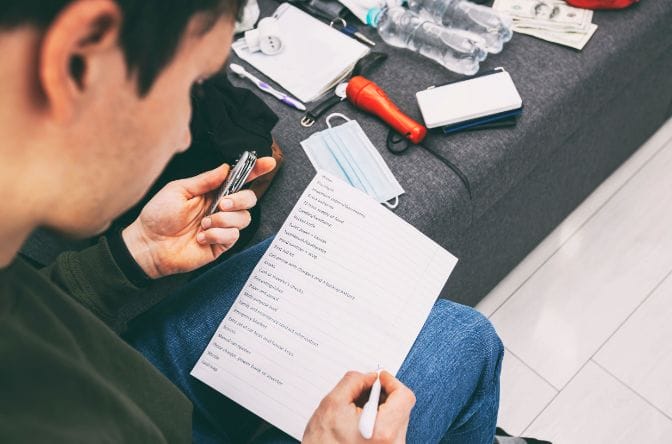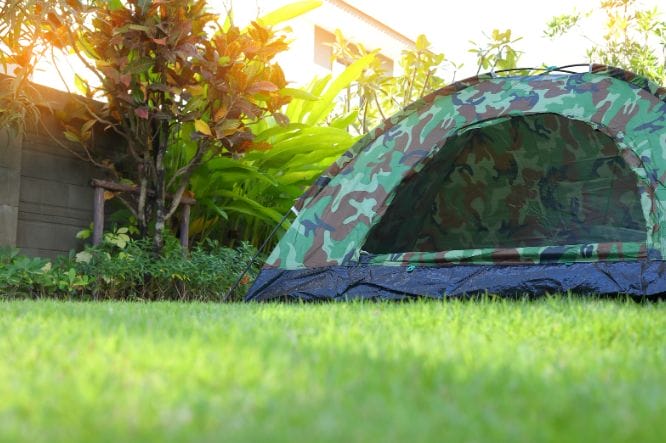 Ask 100 preppers how long they should be prepared for, and you’ll get a lot of different answers. Most will lean toward being prepared for longer periods of time. But the starting point I always encourage is 3 days of preparedness, namely having food on hand that doesn’t require refrigeration and also water. Once you’ve got enough food and water on hand, we would encourage you to stretch that to a 3-week supply. Just 3-weeks will get you through almost every natural disaster that has occurred in the history of the United States. Now, 3 months would be even better. That would help carry you through disasters we have never seen before. We’re increasingly seeing once-in-a-generation storms and events on a more regular basis, along with attacks on our infrastructure and challenges with Russia and China that seem to compound daily, so I would strongly encourage you to shoot for a minimum of 3 months of preparedness. Once you achieve 3 months of preparedness, a year becomes much more obtainable as you’re mostly there…it’s just a matter of scaling up your food. You are also beginning to hopefully learn ways to incorporate these preps into your daily life, such as eating what you store and storing what you eat. We’ll talk about that a little later.
The point here is to decide your target: how long do you want to be prepared for? 3 days, 3 weeks, 3 months, or more? Once you make that decision, it’s time to move to the next step.
STEP 2: FOCUS ON THE PILLARS
Ask 100 preppers how long they should be prepared for, and you’ll get a lot of different answers. Most will lean toward being prepared for longer periods of time. But the starting point I always encourage is 3 days of preparedness, namely having food on hand that doesn’t require refrigeration and also water. Once you’ve got enough food and water on hand, we would encourage you to stretch that to a 3-week supply. Just 3-weeks will get you through almost every natural disaster that has occurred in the history of the United States. Now, 3 months would be even better. That would help carry you through disasters we have never seen before. We’re increasingly seeing once-in-a-generation storms and events on a more regular basis, along with attacks on our infrastructure and challenges with Russia and China that seem to compound daily, so I would strongly encourage you to shoot for a minimum of 3 months of preparedness. Once you achieve 3 months of preparedness, a year becomes much more obtainable as you’re mostly there…it’s just a matter of scaling up your food. You are also beginning to hopefully learn ways to incorporate these preps into your daily life, such as eating what you store and storing what you eat. We’ll talk about that a little later.
The point here is to decide your target: how long do you want to be prepared for? 3 days, 3 weeks, 3 months, or more? Once you make that decision, it’s time to move to the next step.
STEP 2: FOCUS ON THE PILLARS
 So now that we have a timeframe we’re aiming for, let’s focus on the core pillars of prepping. Where do you begin? Here’s our encouragement to you: when starting out, focus on the essential pillars of food, water, energy, medicine, knowledge, and thriftiness. Those last two we will touch upon those a little later. With food, start slow. When you go to the store, buy one extra can of soup, tuna or meat, chili, or vegetables, and set that can aside. Look at the expiration date on the can to get the product with the most extended shelf-life. Canned foods can allow you to build a food reserve for when you have to bug in. If you see a sale, check the expiration to make sure it isn’t old already but maybe buy two or more cans or even a case. Take advantage of deals.
The important thing about canned food is that you should only buy what you can eat. It’s easy to look at these items at the store and purchase food you’ve never eaten before. We don’t recommend that. Also, pick up soups and vegetables. While they may not be calorically dense, they’ll provide a welcome variety and a sense of comfort to you in your time of greatest need.
Beyond just canned food, look to dry goods like hard beans, lentils, rice, amaranth, barley, popcorn, and other hard grains and cereals. They can be stored easily on your shelf for extended periods of time. Start off by focusing on food. If there’s a disaster, food will be the most highly sought-after commodity that is not easily obtained once the stores are cleaned out.
Next, focus on the second pillar, which is water. Start here, and later, as your budget permits, upgrade to storage containers. When we personally started years ago, we went for 5-gallon water storage containers we could put in our closets and, over time, we moved up to 55-gallon drums we have stored in our garage. It didn’t happen overnight; quite the contrary. But our budget helped guide me.
Also, have the means to filter, treat, or boil your water to purify it and make it drinkable. Water is so critical to survival that you can only survive around 3-days without it.
As for the other pillars of energy and medicine, you must assess your needs and requirements here. If you have equipment or medication that you need or your life and health would be in jeopardy, you genuinely need to secure the medicine and energy you need to at least keep yourself safe for 3-days. Regarding medicine, everyone is at a different place with this issue. We would encourage you to learn how to store as much as you need to survive as is legally possible. We know the medical community is increasingly making it harder for people to keep much of an inventory on hand personally, but we would encourage you to chat with your physician about this.
Focus on the pillars of food, water, medicine, and energy, when getting started, and you will likely be just fine. We’ve got blogs covering each of these subjects.
STEP 3: MAKE A BUDGET & PLAN
So now that we have a timeframe we’re aiming for, let’s focus on the core pillars of prepping. Where do you begin? Here’s our encouragement to you: when starting out, focus on the essential pillars of food, water, energy, medicine, knowledge, and thriftiness. Those last two we will touch upon those a little later. With food, start slow. When you go to the store, buy one extra can of soup, tuna or meat, chili, or vegetables, and set that can aside. Look at the expiration date on the can to get the product with the most extended shelf-life. Canned foods can allow you to build a food reserve for when you have to bug in. If you see a sale, check the expiration to make sure it isn’t old already but maybe buy two or more cans or even a case. Take advantage of deals.
The important thing about canned food is that you should only buy what you can eat. It’s easy to look at these items at the store and purchase food you’ve never eaten before. We don’t recommend that. Also, pick up soups and vegetables. While they may not be calorically dense, they’ll provide a welcome variety and a sense of comfort to you in your time of greatest need.
Beyond just canned food, look to dry goods like hard beans, lentils, rice, amaranth, barley, popcorn, and other hard grains and cereals. They can be stored easily on your shelf for extended periods of time. Start off by focusing on food. If there’s a disaster, food will be the most highly sought-after commodity that is not easily obtained once the stores are cleaned out.
Next, focus on the second pillar, which is water. Start here, and later, as your budget permits, upgrade to storage containers. When we personally started years ago, we went for 5-gallon water storage containers we could put in our closets and, over time, we moved up to 55-gallon drums we have stored in our garage. It didn’t happen overnight; quite the contrary. But our budget helped guide me.
Also, have the means to filter, treat, or boil your water to purify it and make it drinkable. Water is so critical to survival that you can only survive around 3-days without it.
As for the other pillars of energy and medicine, you must assess your needs and requirements here. If you have equipment or medication that you need or your life and health would be in jeopardy, you genuinely need to secure the medicine and energy you need to at least keep yourself safe for 3-days. Regarding medicine, everyone is at a different place with this issue. We would encourage you to learn how to store as much as you need to survive as is legally possible. We know the medical community is increasingly making it harder for people to keep much of an inventory on hand personally, but we would encourage you to chat with your physician about this.
Focus on the pillars of food, water, medicine, and energy, when getting started, and you will likely be just fine. We’ve got blogs covering each of these subjects.
STEP 3: MAKE A BUDGET & PLAN
 Now that we’ve determined a timeline and priorities, it’s time to build a budget and start planning. A budget makes all the difference when money is tight, as it defines every dollar that goes out and informs you on how much you can spend on your preps. We’ve spoken about finances many times on the channel, and my own journey of getting my finances squared away. We know the challenges and the freedom that comes with having a budget that can be followed. When we got serious about our finances, we used Dave Ramsey’s book, financial peace, which really helped us understand ways to stick with a budget. Maybe there’s another financial guru you like, but the key is to form a budget and follow it. Trust me, it made a big difference.
Also, check out our free Recession Proofing guide, which is a great way to harden yourself off from economic downturns fiscally that covers practical approaches to saving money, so I encourage you to start there. Then look at the Introductory Prepper’s Guide to form a plan to get moving. Forming a budget, using our recession-proof guide, and then following our introductory prepper’s guide will get you started.
STEP 4: CHANGE THE WAY YOU LIVE & EAT
Now that we’ve determined a timeline and priorities, it’s time to build a budget and start planning. A budget makes all the difference when money is tight, as it defines every dollar that goes out and informs you on how much you can spend on your preps. We’ve spoken about finances many times on the channel, and my own journey of getting my finances squared away. We know the challenges and the freedom that comes with having a budget that can be followed. When we got serious about our finances, we used Dave Ramsey’s book, financial peace, which really helped us understand ways to stick with a budget. Maybe there’s another financial guru you like, but the key is to form a budget and follow it. Trust me, it made a big difference.
Also, check out our free Recession Proofing guide, which is a great way to harden yourself off from economic downturns fiscally that covers practical approaches to saving money, so I encourage you to start there. Then look at the Introductory Prepper’s Guide to form a plan to get moving. Forming a budget, using our recession-proof guide, and then following our introductory prepper’s guide will get you started.
STEP 4: CHANGE THE WAY YOU LIVE & EAT
 You need to learn to prepare and cook the food that you’re storing. Eat what you store and store what you eat. And with spring right around the corner, we would highly encourage you to start a garden, no matter how large or small. When we started gardening, we had no idea what we were doing, and we’re still learning. But that’s the key: We are learning. We still probably kill more plants than we keep alive, but we’re better than we were the day we started. Now, sometimes we bring in bumper crops of some vegetables, and we learn about the low-yielding plants and find out why they produce so little. We realize we can’t survive solely by growing my food if everything were to fall apart. As we’ve been covering on the channel lately, we are working on garden setups for small spaces. We’ve already done several blogs on this and will be doing more in the coming weeks. When springtime hits, we’ll start showing you how to practically implement the approaches we’ve outlined by showing you the setups we’ll be making on our back patio.
Our point here is that we can’t wait until disaster strikes and then instantly be the expert on all things. We recognized long ago that we needed to change how we lived and incorporate knowledge, skills, and thriftiness into my daily practices. That mindset doesn’t require me to spend even a penny of my money, but it will be my most valuable resource after a disaster.
Finally, change the way you are living your life. If you’re sitting on the couch, get up if you can. Go for a walk, hike, or exercise. If you have a sedentary life at all, this is the day you need to change that. Get up and stretch. Increased physical activity leads to physical and physiological changes in your body’s chemistry. It can change your perspective and help you build a survivor’s mentality. More importantly, moving around more and getting healthy doesn’t have to cost you a dime.
STEP 5: TURN OFF THE LIGHTS & GO CAMPING
You need to learn to prepare and cook the food that you’re storing. Eat what you store and store what you eat. And with spring right around the corner, we would highly encourage you to start a garden, no matter how large or small. When we started gardening, we had no idea what we were doing, and we’re still learning. But that’s the key: We are learning. We still probably kill more plants than we keep alive, but we’re better than we were the day we started. Now, sometimes we bring in bumper crops of some vegetables, and we learn about the low-yielding plants and find out why they produce so little. We realize we can’t survive solely by growing my food if everything were to fall apart. As we’ve been covering on the channel lately, we are working on garden setups for small spaces. We’ve already done several blogs on this and will be doing more in the coming weeks. When springtime hits, we’ll start showing you how to practically implement the approaches we’ve outlined by showing you the setups we’ll be making on our back patio.
Our point here is that we can’t wait until disaster strikes and then instantly be the expert on all things. We recognized long ago that we needed to change how we lived and incorporate knowledge, skills, and thriftiness into my daily practices. That mindset doesn’t require me to spend even a penny of my money, but it will be my most valuable resource after a disaster.
Finally, change the way you are living your life. If you’re sitting on the couch, get up if you can. Go for a walk, hike, or exercise. If you have a sedentary life at all, this is the day you need to change that. Get up and stretch. Increased physical activity leads to physical and physiological changes in your body’s chemistry. It can change your perspective and help you build a survivor’s mentality. More importantly, moving around more and getting healthy doesn’t have to cost you a dime.
STEP 5: TURN OFF THE LIGHTS & GO CAMPING
 Once you have low-budget prepped for a few months, it’s time for a trial run to understand your preps and harden yourself off to adversity. Go ahead and run the emergency evacuation drill for your family. Flip the power off at the main breaker to your house for the weekend, document what you would do, and assess what you may have overlooked. Plan an overnight camping trip or pitch a tent in your backyard with just your bug-out gear. Understand the difference between the survival movies Hollywood feeds us and what it really takes to survive for a day or three without the luxuries and comforts we have in abundance and barely consider.
Your practice session doesn’t have to be that dramatic. It can simply be turning to your food and water preps and committing to eat and drink only those for three days. That simple exercise will teach you volumes about your supplies and the gaps in them. The practice will allow you to replace your preps with greater purpose and intent. Turning to your food preps like this every so often will save you the money you can apply to your future preps, replace existing supplies, or get the new supplies you now realize you need. The key is putting your resources, knowledge, and skills into practice.
You don’t have to be perfect. In fact, you want to fail here and there to understand where the gaps in your preps are. This is about putting forth a little effort periodically. This is where the transformation into the prepper you decided and committed to being earlier occurs. This is where the change occurs– with every effort and every bit of practice.
20 QUICK TIPS
Much of what we already discussed here are things you can start doing today at little to no expense. Decide what you want to prepare for, get or build a personal plan, take advantage of our free guides, build your core preps slowly over time, change the way you live and eat now, and then put it all into practice. All of those can be done with even the most limited of funds, but we also want to leave you with 20 quick tips for prepping with little to no budget. Over the years of doing this, as you might imagine, we get quite a few tips and tricks sent to us. We cover many of these in other blogs on this site, or you can find best practices with a few simple internet searches.
Here they are, super quickly:
Once you have low-budget prepped for a few months, it’s time for a trial run to understand your preps and harden yourself off to adversity. Go ahead and run the emergency evacuation drill for your family. Flip the power off at the main breaker to your house for the weekend, document what you would do, and assess what you may have overlooked. Plan an overnight camping trip or pitch a tent in your backyard with just your bug-out gear. Understand the difference between the survival movies Hollywood feeds us and what it really takes to survive for a day or three without the luxuries and comforts we have in abundance and barely consider.
Your practice session doesn’t have to be that dramatic. It can simply be turning to your food and water preps and committing to eat and drink only those for three days. That simple exercise will teach you volumes about your supplies and the gaps in them. The practice will allow you to replace your preps with greater purpose and intent. Turning to your food preps like this every so often will save you the money you can apply to your future preps, replace existing supplies, or get the new supplies you now realize you need. The key is putting your resources, knowledge, and skills into practice.
You don’t have to be perfect. In fact, you want to fail here and there to understand where the gaps in your preps are. This is about putting forth a little effort periodically. This is where the transformation into the prepper you decided and committed to being earlier occurs. This is where the change occurs– with every effort and every bit of practice.
20 QUICK TIPS
Much of what we already discussed here are things you can start doing today at little to no expense. Decide what you want to prepare for, get or build a personal plan, take advantage of our free guides, build your core preps slowly over time, change the way you live and eat now, and then put it all into practice. All of those can be done with even the most limited of funds, but we also want to leave you with 20 quick tips for prepping with little to no budget. Over the years of doing this, as you might imagine, we get quite a few tips and tricks sent to us. We cover many of these in other blogs on this site, or you can find best practices with a few simple internet searches.
Here they are, super quickly:
- Use BPA-free unused soda or water bottles for water, rice, bean, or grain storage.
- Grow and eat something, even if that’s just sprouts on the window sill.
- Cook your own food, so you learn and save money.
- Dehydrate food.
- Learn to forage, hunt, or fish in your local area, then process and eat what you gather.
- Invest in a good map and learn to read a compass.
- Build a bugout or everyday carry bag.
- Build your pantry one can at a time.
- Build a great first aid kit one item at a time.
- Repair, recycle, and reuse containers, anything and everything.
- Get rechargeable batteries and devices, and a means to charge them without central power.
- Learn to save seeds and start a windowsill garden.
- Form a buying co-op to get more for less and split it up.
- Buy one bag of rice, dry beans, and a few Ramen with each trip to the store.
- Buy one extra canned good and one bag of pasta per trip to the store.
- Don’t throw out gently used trainers or sneakers. Put them in your bug-out bag stuffed with extra socks.
- Buy zip ties, bungee cords, a paracord, and a tarp. They’re amazingly useful.
- Stock up on garbage bags and wet wipes.
- Have emergency mylar blankets in your bags.
- Pack new small games for kids and a deck of cards.

